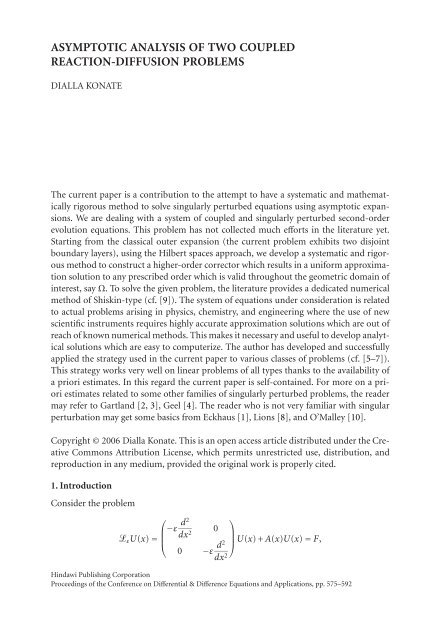DIFFERENtIAl & DIFFERENCE EqUAtIONS ANd APPlICAtIONS
DIFFERENtIAl & DIFFERENCE EqUAtIONS ANd APPlICAtIONS
DIFFERENtIAl & DIFFERENCE EqUAtIONS ANd APPlICAtIONS
Create successful ePaper yourself
Turn your PDF publications into a flip-book with our unique Google optimized e-Paper software.
ASYMPTOTIC ANALYSIS OF TWO COUPLED<br />
REACTION-DIFFUSION PROBLEMS<br />
DIALLA KONATE<br />
The current paper is a contribution to the attempt to have a systematic and mathematically<br />
rigorous method to solve singularly perturbed equations using asymptotic expansions.<br />
We are dealing with a system of coupled and singularly perturbed second-order<br />
evolution equations. This problem has not collected much efforts in the literature yet.<br />
Starting from the classical outer expansion (the current problem exhibits two disjoint<br />
boundary layers), using the Hilbert spaces approach, we develop a systematic and rigorous<br />
method to construct a higher-order corrector which results in a uniform approximation<br />
solution to any prescribed order which is valid throughout the geometric domain of<br />
interest, say Ω. To solve the given problem, the literature provides a dedicated numerical<br />
method of Shiskin-type (cf. [9]). The system of equations under consideration is related<br />
to actual problems arising in physics, chemistry, and engineering where the use of new<br />
scientific instruments requires highly accurate approximation solutions which are out of<br />
reach of known numerical methods. This makes it necessary and useful to develop analytical<br />
solutions which are easy to computerize. The author has developed and successfully<br />
applied the strategy used in the current paper to various classes of problems (cf. [5–7]).<br />
This strategy works very well on linear problems of all types thanks to the availability of<br />
a priori estimates. In this regard the current paper is self-contained. For more on a priori<br />
estimates related to some other families of singularly perturbed problems, the reader<br />
may refer to Gartland [2, 3], Geel [4]. The reader who is not very familiar with singular<br />
perturbation may get some basics from Eckhaus [1], Lions [8], and O’Malley [10].<br />
Copyright © 2006 Dialla Konate. This is an open access article distributed under the Creative<br />
Commons Attribution License, which permits unrestricted use, distribution, and<br />
reproduction in any medium, provided the original work is properly cited.<br />
1. Introduction<br />
Consider the problem<br />
⎛<br />
ε U(x) = ⎜<br />
⎝<br />
−ε d2<br />
⎞<br />
dx 2 0<br />
⎟<br />
0 −ε d2 ⎠U(x)+A(x)U(x) = F,<br />
dx 2<br />
Hindawi Publishing Corporation<br />
Proceedings of the Conference on Differential & Difference Equations and Applications, pp. 575–592

















